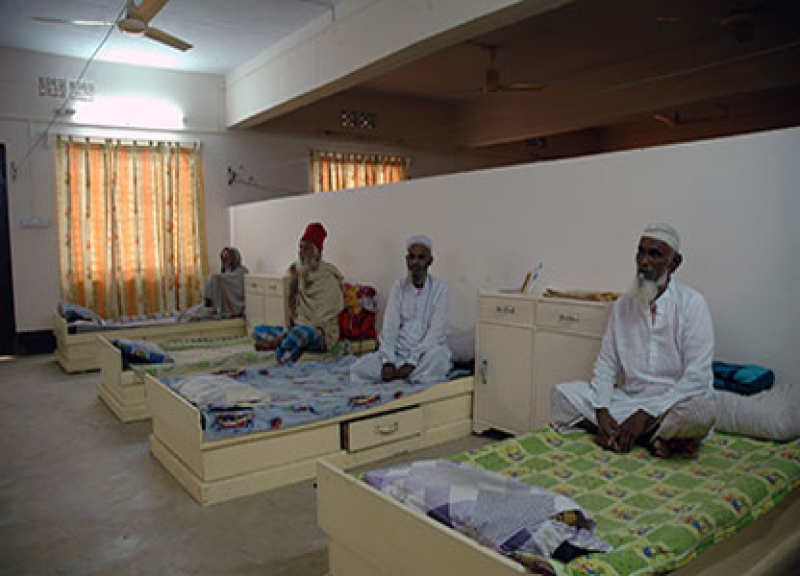- CA Yunus pays homage to Liberation War martyrs on Victory Day |
- Bangladesh capital market extends losing streak for second day |
- Bangladesh celebrates Victory Day Tuesday |
- 'Different govts presented history based on their own ideologies': JU VC |
Aged and Alone: The hidden pains in old age homes

Inmates of old-age homes in Dhaka City
By Amy Jannat
Dhaka, April 11 - In the twilight years of life when the presence of children is expected to be the ultimate comfort, many elderly parents in Bangladesh are instead met with neglect, abandonment and heartbreaking silence.
The cold reality for thousands is a one-way journey to old age homes, not by choice, but by circumstances.
From cities to suburbs, stories unfold in these quiet shelters— the stories of once-vibrant lives now wrapped in sorrows.
Some have no family at all; others do, but their children live abroad or live nearby and yet remain distant, emotionally absent.
Wealth, status, or sacrifice does not guarantee care. A simple phone call, a heartfelt check-in—many don’t even receive that.
At the heart of the capital, in Agargaon, stands the ‘Prabin Nibash’—an old age home under the Ministry of Social Welfare.
Here reside people who once held power, respect, and dreams. One of them is Sohana (not her real name), a nearly 60-year-old woman who carries the quiet ache of a mother’s unspoken pain.
“My husband passed away years ago. My two daughters now live in Canada and the USA with their families,” she shares, her voice calm but heavy.
“I live alone on Indira Road. Whenever I feel too lonely, I come here. I celebrate festivals, birthdays—any occasion—at this home now. Not with them,” she said.
Sohana’s life, by most standards, is secure. “We own a house in Dhaka. We’ve rented out three large flats. My daughters are well-educated. There’s no shortage of money,” she says.
“On March 31, there was a celebration. I called them. They didn’t have time to talk,” she added.
Once a Deputy Director at the Department of Social Services, Sohana never imagined this solitude. “This home has no family ties for me. Yet, it brings comfort. Some stay here because they’ve been abandoned. Some are divorced. Others come out of sheer frustration. I first came for therapy, but now I stay for 15–20 days each month.”
Sitting beside her is Afroza (not her real name), aged 65. A woman of strength, she too had a career in government service. Her words, however, reflect a quiet resignation. “My husband passed away. My children are doing well. But I became a burden. I realised that. So, I left.”
She adds, “I still receive visitors—relatives, old friends. But I won’t return. It’s better to live here with dignity than stay where I feel unwanted.”
Then there's Mujibur Hossain, an 80-year-old father who has spent nearly 25 years at the ‘Prabin Nibash’.
Owner of a luxurious flat in Dhanmondi, he chose to leave it all behind. With three daughters and a son, Mujibur was once surrounded by family. But over time, space for him disappeared from their lives.
“I left out of resentment,” he said.
Since then, not one of his children has asked him to return.
These stories are not isolated. They echo through the halls of old age homes across the country. Some are filled with bitter silence, others with occasional laughter.
Nearby, a Senior Citizens Hospital offers medical attention when needed—but the emotional wounds remain unhealed.
According to Nazeem, a guard at the Agargaon facility, the current number of residents at the Senior Citizens Home stands at 29—13 women and 16 men.
The home is supported by the Department of Health Services and the Department of Social Services.
The Growing Web of Old Age Homes in Bangladesh
At present, there are six government-run old age homes across Bangladesh under the Ministry of Social Welfare.
Together, they can accommodate up to 300 elderly individuals. With the ageing population steadily rising, both public and private initiatives have sought to fill the gap. In total, more than 32 such homes exist nationwide.
Experts attribute this growing dependence on institutional care to the collapse of the joint family system—a cornerstone of traditional Bangladeshi society.
As family structures shift and urban lifestyles take precedence, elderly parents find themselves increasingly isolated.
The emotional distance between generations grows wider, leaving many parents to live out their final days in unfamiliar rooms with strangers who slowly become family.
Behind every face in these homes lies a lifetime of sacrifice, love and longing. Yet, in many cases, what remains are not warm memories—but tears in silence. - UNB

